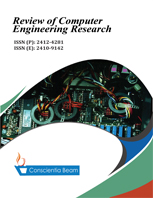Buried Wire Detection and Clustering Algorithm with Ground Penetrating Radar
DOI:
https://doi.org/10.18488/76.v9i4.3168Abstract
Improvised explosive devices (IEDs) have recently become a considerable national security concern for governments due to their increased use. Since IEDs do not have a particular shape, detecting and classifying IEDs becomes a complex problem. Due to the irregularity of the wire shape, recent research focuses on detecting command wire, which is the triggering mechanism in IEDs. This study proposes a detection and clustering algorithm for wire detection. The synthetic data were generated using the gprMax software, an open-source Finite-Difference Time-Domain (FDTD) simulation environment. Different wire and clutter orientations were simulated while creating a 2D GPR database. Three different prescreening algorithms are compared concerning computational time and signal-to-noise ratio. The Go Decomposition (GoDec) method was used at the preprocessing stage. Discriminating the buried wire from clutter was conducted using the k-means clustering method. The proposed algorithm results show promising outcomes over simulated GPR 2D C-scans.





